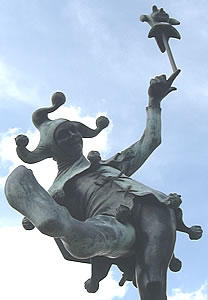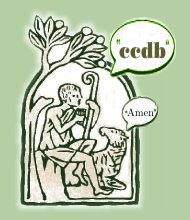The Curt Jester on "The First Thanksgiving"
The Curt Jester has his annual surprise for Plymouth zealots.
When on September 8, 1565 Pedro Menéndez de Avilés and his 800 Spanish settlers founded the settlement of St. Augustine in La Florida, the landing party celebrated a Mass of Thanksgiving, and, afterward, Menéndez laid out a meal to which he invited as guests the native Seloy tribe who occupied the site.I confess (again!) that I have long held the historical bias of which this professor speaks. I somehow discount Florida when I think of the United States because the first American colony was not among the original Thirteen. Still, history has spoken. Clearly, the settlers of St. Augustine deserve the credit for having celebrated the first Thanksgiving in America!
The celebrant of the Mass was St. Augustine’s first pastor, Father Francisco Lopez de Mendoza Grajales, and the feast day in the church calendar was that of the Nativity of the Blessed Virgin Mary. What exactly the Seloy natives thought of those strange liturgical proceedings we do not know, except that, in his personal chronicle, Father Lopez wrote that “the Indians imitated all they saw done.”
What was the meal that followed? Again we do not know. But, from our knowledge of what the Spaniards had on board their five ships, we can surmise that it was cocido, a stew made from salted pork and garbanzo beans, laced with garlic seasoning, and accompanied by hard sea biscuits and red wine. If it happened that the Seloy contributed to the meal from their own food stores, fresh or smoked, then the menu could have included as well: turkey,venison, and gopher tortoise; seafood such as mullet, drum, and sea catfish; maize (corn),beans and squash.
What is important historically about that liturgy and meal was stated by me in a 1965 book entitled The Cross in the Sand: “It was the first community act of religion and thanksgiving in the first permanent [European] settlement in the land.” The keyword in that sentence was “permanent.” Numerous thanksgivings for a safe voyage and landing had been made before in Florida, by such explorers as Juan Ponce de León, in 1513 and 1521, Pánfilo de Narváez in 1528, Hernando de Soto in 1529, Father Luis Cáncer de Barbastro in 1549, and Tristán de Luna in 1559. Indeed French Calvinists (Huguenots) who came to the St. Johns River with Jean Ribault in 1562 and René de Laudonnière in 1564 similarly offered prayers of thanksgiving for their safe arrivals. But all of those ventures, Catholic and Calvinist, failed to put down permanent roots.
St. Augustine’s ceremonies were important historically in that they took place in what would develop into a permanently occupied European city, North America’s first. They were important culturally as well in that the religious observance was accompanied by a communal meal, to which Spaniards and natives alike were invited. The thanksgiving at St. Augustine, celebrated 56 years before the Puritan-Pilgrim thanksgiving at Plymouth Plantation (Massachusetts), did not, however, become the origin of a national annual tradition, as Plymouth would. The reason is that, as the maxim holds, it is the victors who write the histories.
(snip)
The historical fact remains that St. Augustine’s thanksgiving not only came earlier; it was the first to take place in a permanent settlement. The Ancient City deserves national notice for that distinction.
Perhaps most of New England is now willing to concede as much, though that was not the case in November 1985, when an Associated Press reporter built a short Thanksgiving Day story around my aforesaid sentence of 20 years before in The Cross in the Sand. When his story appeared in Boston and other papers, New England went into shock. WBZ-TV in Boston interviewed me live by satellite for its 6:00 p.m. regional news
program.
The newsman told me that all of Massachusetts was “freaked out,” and that, as he spoke, “the Selectmen of Plymouth are holding an emergency meeting to contend with this new information that there were Spaniards in Florida before there were Englishmen in Massachusetts.”
I replied, “Fine. And you can tell them for me that, by the time the Pilgrims came to Plymouth, St. Augustine was up for urban renewal.”
'Twould be grand if this caught on in the elementary schools. C'mon, now, admit it! You'd love to see the little ones dressed in conquistador armor rather than Puritan garb!





















<< Home